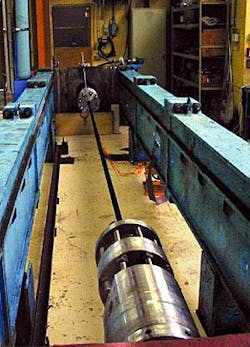FRANCE: Carbon fiber tethers key for ultra-deepwater production
Pierre Odru,Institut Francais du Petrole
René Louis Geffroy, Freyssinet
Exploration and production has moved resolutely into the ultra-deepwater realm. Production developments in the Gulf of Mexico, West Africa, and Brazil are becoming commonplace in the 1,000-2,000-m depth range, and drilling exploration is now targeted for 3,000 m.
From the structural point of view, however, many difficulties are still being identified at these depths. The weight of the riser and mooring systems is a recurrent problem that increases with depth. Innovative developments have been proposed to overcome these difficulties, such as the use of low density polyester mooring, or advanced composite materials.
Among deepwater field development solutions, TLPs, through their great stability, allow use of dry trees with their associated advantages. Numerous TLPs have been built and installed in the Gulf of Mexico and the North Sea. They are now also being considered for the Gulf of Guinea and the Campos basin. However, their ability to operate in depths of 1,500 m and beyond largely depends on efforts to decrease of the weight of the mooring tethers, which ensure their stability.
Until now, these tethers have been made out of air-filled steel tubes, designed to be neutrally buoyant. In increasing water depths, however, the influence of the collapse pressure leads to heavy steel thickness, requiring the size of the TLP to increase to support their weight, with significant associated extra costs.
Carbon fibers offer qualities such as low weight, high stiffness, mechanical strength, and fatigue and corrosion resistance, which make them ideal candidates to meet the challenge of providing lightweight tethers. Preliminary studies have been carried out in France by Doris Engineering and the Institut Francais du Petrole, to establish their technical and economic potential.
Due to fatigue problems, steel TLP tethers have to be designed with sufficient stiffness to keep the natural heave period of the platform below 4 sec (the period above which springing and ringing fatigue damage becomes significant). Such a requirement would not make optimal use of the carbon fiber's high strength.
The research team felt that the carbon fibers could withstand the effects of a higher natural period of the heave movement of a TLP without difficulty, because of their very good fatigue properties, which could result in a more economic solution. Simulations were therefore performed of the behavior of different sizes of TLPs in environments ranging from severe (North Sea) to mild (Gulf of Guinea). These studies confirmed the potential capabilities of carbon fiber tethers.
The decision was made to develop a tether for such an application. Soficar, a carbon fiber manufacturer, devised a method for pultruding 6-mm diameter rods with a tensile performance very close to the ideal value. Freyssinet, a specialist in cable-stayed bridges, then developed the anchoring system that allows the transmission of loads between the steel structure and the carbon fiber tethers.
The resultant composite carbon fiber cable features a modular design designed to offer high flexibility. It is composed of sub-elements of 19 rods in a hexagonal grouping, with an external 2-mm thick PEHD sheath. Voids between rods are filled with a waterproof polymer to help the composite withstand high hydrostatic pressures and to protect it against friction effects.
The number of rods, or the number of sub-elements used, can be tailored to requirements. Each module has a hexagonal shape, allowing any number of modules to be assembled, honeycomb fashion, into a 35-mm thick PEHD sheath. Voids between modules are also filled with non-compressible polymer to help the tether withstand hydrostatic pressure.
Among the benefits of this approach are:
- High level of flexibility to design the required capacity of the cable
- High level of safety because each sub-element works individually, with no propagation of defects as in a bulk material
- No size limit for the mooring system
- Testing characteristics of individual sub elements are representative of the entire tether assembly.
IFP carried out three fatigue tests on sub-element cables supplied by Freyssinet comprising 19 rods with their anchorings. The upper limit of the load was 45% of the ultimate. For each test, 2.1 million cycles were applied. The first cable was tested with dynamic amplitude of 400 MPa, corresponding to the hundred-year wave. For the second and third tests, the amplitude was 600 MPa, corresponding to the thousand-year wave. The main conclusion was that there were no detectable effects of fatigue either during the fatigue tests themselves or during subsequent tensile failure tests. In each case, the ultimate tension was very close to failure tensions of un-fatigued specimens.
The technology has found its initial application on the Laroin cable-stayed footbridge in the south of France, where all 16 cables that support the central span are made of carbon fibers. The companies are now approaching oil companies to identify a first application or test offshore.
For more information, contact [email protected] or [email protected].

